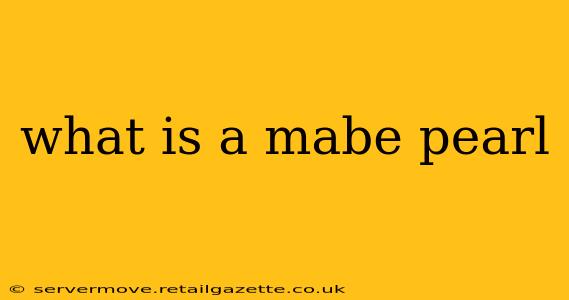Mabe pearls, often mistaken for their more famous cousins, the cultured pearls, are unique and captivating gems possessing a distinct charm. Unlike traditionally cultured pearls which are perfectly round or near-round, mabe pearls are characterized by their half-pearl nature. They are cultivated within the shell of a mollusk, usually an oyster, and are attached to the inner shell wall, resulting in a single, flat, or concave back. This creates a unique, organic form often appreciated for its irregularity and natural beauty.
This guide will delve into the intricacies of mabe pearls, answering common questions and shedding light on their captivating characteristics.
How are Mabe Pearls Made?
Mabe pearl cultivation is a fascinating process, differing significantly from the methods used to produce traditionally round pearls. Instead of inserting a nucleus (a small bead) into the oyster's mantle tissue, a small, carefully prepared piece of shell or bead is inserted and placed against the inside of the oyster's shell. The oyster then coats this irritant with layers of nacre, the iridescent substance that creates the pearl's luster. Over time, this process builds up a beautiful, lustrous half-pearl attached to the shell.
This method is less complex than creating fully spherical pearls, contributing to their often more affordable price point compared to round cultured pearls.
What is the Difference Between Mabe Pearls and Cultured Pearls?
The most significant difference lies in their shape and formation. Cultured pearls are typically round, near-round, or baroque (irregularly shaped), and are formed freely within the oyster's mantle. Mabe pearls, on the other hand, are always half-pearls, attached to the inside of the oyster shell. This inherent difference in cultivation impacts their appearance and how they're used in jewelry.
What Makes Mabe Pearls Valuable?
While generally less expensive than perfectly round cultured pearls, mabe pearls still hold value, particularly when considering the following:
- Rarity of Color and Luster: Like other pearls, the color and luster of a mabe pearl significantly influence its worth. Rare colors and exceptional luster command higher prices.
- Size and Shape: Larger mabe pearls with interesting and unique shapes are more valuable. The overall aesthetic appeal plays a crucial role.
- Quality of Nacre: The thickness and quality of the nacre coating influence the pearl's durability and overall beauty. A thicker layer of smooth, lustrous nacre is highly prized.
- Origin: The source of the mabe pearls can sometimes contribute to their value, with pearls from certain regions being considered more desirable due to factors influencing pearl quality.
Are Mabe Pearls Real Pearls?
Yes, mabe pearls are indeed real pearls. They are formed through the same natural process of nacre secretion by a mollusk, albeit using a slightly different cultivation method. The distinction lies in their attachment to the shell, not in their authenticity.
How are Mabe Pearls Used in Jewelry?
Due to their shape, mabe pearls are uniquely suited for certain jewelry designs. They are frequently used in:
- Earrings: Their flat or concave back makes them ideal for creating elegant and unique earring designs.
- Pendants: Mabe pearls often feature prominently in pendant designs, showcasing their unique beauty.
- Brooches: The irregular shapes of mabe pearls can lend themselves beautifully to intricate brooch designs.
- Rings: While less common than in earrings or pendants, mabe pearls can add a touch of elegance to ring designs.
How Can I Tell if a Mabe Pearl is Real?
Authenticity verification requires expertise. However, some indicators of real mabe pearls include:
- Natural Imperfections: Real mabe pearls may exhibit minor surface imperfections, unlike perfectly flawless imitations.
- Luster: Real mabe pearls possess a beautiful, subtle luster that is hard to replicate artificially.
- Weight: Genuine mabe pearls generally feel heavier than imitation pearls.
Ultimately, consulting a reputable gemologist or jeweler is the best way to ensure the authenticity of any pearl.
By understanding the unique characteristics and cultivation process of mabe pearls, you can appreciate their inherent beauty and the craftsmanship involved in creating these exquisite gems. Their distinctive half-pearl nature and organic forms make them a truly captivating alternative to traditional cultured pearls.
